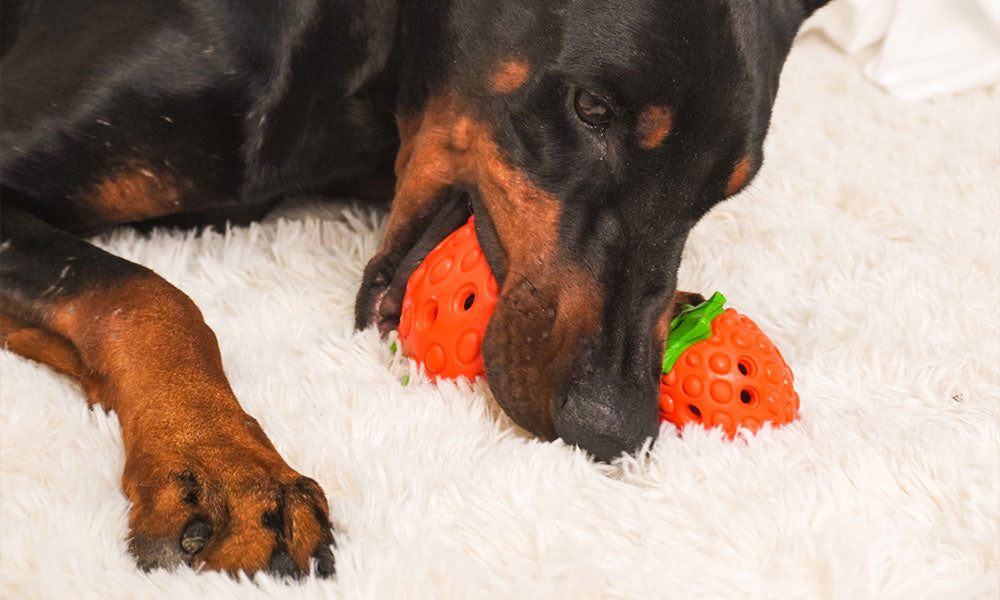Is Your Dog Getting Enough Mental Stimulation?

Share
Why Mental Stimulation Matters
We all know dogs need walks, runs, and maybe a good game of fetch. But what about their brains? Yep, dogs need to think, solve, and learn—just like we do. Giving your dog mental stimulation isn’t just a “nice to have”—it’s essential.
The Link Between Brain Work and Behavior
Think of your dog’s brain like a muscle. If it’s not being exercised, it gets rusty. Dogs that use their brains regularly tend to be more balanced, better-behaved, and even happier. It’s not magic; it’s science.
Not Just Physical: The Mental Exercise Gap
Sure, physical activity burns energy. But mental stimulation drains energy in a different (and surprisingly effective) way. A 15-minute sniffing game can wear your pup out just as much as a brisk 30-minute walk. Crazy, right?
Signs Your Dog Might Be Bored
Let’s play detective. Is your dog acting out, or just plain uninterested in life? These could be red flags that your dog is mentally under-challenged.
Destructive Behavior
Chewed-up shoes, shredded pillows, or gnawed table legs? Your pup may be trying to tell you something: “I’m bored, help me!”
Excessive Barking or Whining
It’s not always about needing to pee. Barking can be a cry for attention or a way to release pent-up energy—especially if it happens around the same time every day.
Lethargy or Depression
On the flip side, some dogs go into low-energy mode when under-stimulated. They may sleep too much or seem uninterested in play or people.
How Much Mental Stimulation Does a Dog Need?
There’s no one-size-fits-all answer. Just like people, dogs have different personalities and thresholds.
Different Breeds, Different Needs
Working breeds like Border Collies, Australian Shepherds, or Belgian Malinois were born to think. These dogs need puzzles, challenges, and tasks. Meanwhile, more relaxed breeds like Bulldogs still benefit from mental games but might not crave them as intensely.
Age and Energy Levels
Puppies are learning machines. Their brains are wired for curiosity and chaos. Older dogs might move slower, but they still love a good brain game—plus, it keeps them sharp and alert.
Simple Ways to Challenge Your Dog's Mind
Here comes the fun part: how to actually do it. You don’t need fancy gear or hours of training—just creativity and a few minutes a day.
Puzzle Toys and Treat Dispensers
Interactive Dog Toys that make your dog work for food? Game-changer. From Kongs to treat balls, these tools engage problem-solving skills and reward effort.
Training New Tricks (Even Old Dogs Can Learn!)
“Sit” and “stay” are just the beginning. Try teaching your dog to spin, fetch specific toys, or even tidy up their own toys (yes, really!).
Hide-and-Seek and Nose Work
Dogs were born to sniff. Hiding treats around the house or yard turns your pup into a four-legged detective. Bonus: it tires them out without tiring you out.
Interactive Playtime Ideas
Switch things up. Play tug, use flirt poles, or toss in short training sessions during play. Keep your dog guessing, and they’ll stay mentally engaged.
Daily Routine Ideas for Brain Boosting
Let’s weave mental stimulation right into your dog’s day.
Rotate Toys Weekly
Leave out a few toys at a time and rotate them weekly to keep things fresh. It’s like your dog gets a new batch of toys every seven days—without the extra cost.
Use Mealtime for Enrichment
Ditch the bowl. Scatter food in the yard, use a snuffle mat, or stuff kibble into a puzzle feeder. Turn chow time into a mini treasure hunt.
Social Interaction Counts, Too
Dogs are pack animals. Being around others isn’t just fun—it’s mentally enriching.
Doggy Playdates and Daycare
Let your dog mingle. Social interaction with other dogs (and humans) can mentally stimulate and teach valuable social cues. Plus, it’s a blast.
Walks with Variety and Purpose
Try a new route, let them sniff freely, or practice tricks mid-walk. A walk isn’t just a potty break—it’s a chance to explore the world.
What Happens When Dogs Don’t Get Enough?
Let’s not sugarcoat it. Mental neglect can lead to real issues.
Stress and Anxiety Build-Up
A bored brain is a restless brain. Dogs without enough to think about can develop anxiety or obsessive behaviors, like tail chasing or paw licking.
Long-Term Health Impact
Just like people, mentally under-stimulated dogs may face cognitive decline earlier. Engaging their brains can help delay aging and boost quality of life.
Balancing Physical and Mental Exercise
It’s not either/or—it’s both. Think of mental and physical exercise as the yin and yang of a happy pup. A walk followed by a treat puzzle? That’s the sweet spot.
Final Thoughts
So, is your dog getting enough mental stimulation? If you’ve made it this far, you probably care deeply—and that’s already a great sign. Dogs don’t need endless toys or hours of training. They need variety, interaction, and a bit of brain work every day.
Think of your dog’s mind like a garden. Tend to it, feed it, and it will bloom into something beautiful—calm, focused, and happy.
FAQs
1. How do I know if my dog is mentally stimulated enough?
Look for balance. If your dog seems content, focused, and not destructive, you’re probably on the right track. If not, try introducing a few new games or training sessions.
2. Can mental stimulation replace physical exercise?
Not entirely. It’s best to mix both. But on bad-weather days, mental games are a great substitute or supplement.
3. Are puzzle toys worth the money?
Definitely. Many dogs love them, and they’re reusable. You can even DIY some using toilet paper rolls or muffin tins.
4. What if my dog loses interest in toys quickly?
Rotate them and don’t leave all toys out at once. Try interactive play instead of passive toys.
5. How often should I train my dog mentally?
Aim for short sessions daily—5 to 15 minutes of mental play is a great start. It adds up fast and makes a big difference.




